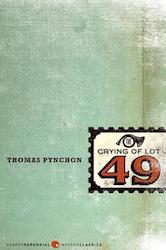
It’s been twenty-five years since I’ve last read any Pynchon (his first novel, V.) and I’m not sure the distance has made me any fonder of his work.
The Crying of Lot 49 is his second novel (and the shortest of his works, I believe). It follows the journey of Mrs. Oedipa Maas after she is named executrix of the estate of her former lover Pierce Inverarity, a real estate mogul.
As Oedipa starts to sift through all the branches and details of Pierce’s holdings, however, she begins to see connections everywhere and starts to uncover the story of a secret society dating back to the thirteenth century.
Oedipa is not exactly stable, however, and she begins to wonder if this conspiracy she seems to be unearthing is real. Or is it an elaborate hoax? Is it just an invention of her own paranoia?
Published in 1966, The Crying of Lot 49 is now a standard text of the American postmodern era, where notions of objective truth are shattered, where parody is favored over realism, and where an author privileges obscurity and elitism over accessibility.
There are moments that are uproariously funny, reminiscent of the absurdist humor in Joseph Heller’s 1961 novel, Catch-22. But for me, at least, it doesn’t work for Pynchon like it did for Heller. It’s almost as if Pynchon tried too hard to hide the smart kid in school behind a screen of ridiculous jokes and allusions. Even in a short work like this, it grows tedious quickly.
It’s been said that this is the most linear of all Pynchon’s works, which I admit does not make me want to try his longer novels. I just don’t have an appreciation for that kind of distancing stance between authorial voice and reader. Whether that’s my own failing or Pynchon’s I’ll leave to smarter readers to discern.
The Crying of Lot 49 is his second novel (and the shortest of his works, I believe). It follows the journey of Mrs. Oedipa Maas after she is named executrix of the estate of her former lover Pierce Inverarity, a real estate mogul.
As Oedipa starts to sift through all the branches and details of Pierce’s holdings, however, she begins to see connections everywhere and starts to uncover the story of a secret society dating back to the thirteenth century.
Oedipa is not exactly stable, however, and she begins to wonder if this conspiracy she seems to be unearthing is real. Or is it an elaborate hoax? Is it just an invention of her own paranoia?
Published in 1966, The Crying of Lot 49 is now a standard text of the American postmodern era, where notions of objective truth are shattered, where parody is favored over realism, and where an author privileges obscurity and elitism over accessibility.
There are moments that are uproariously funny, reminiscent of the absurdist humor in Joseph Heller’s 1961 novel, Catch-22. But for me, at least, it doesn’t work for Pynchon like it did for Heller. It’s almost as if Pynchon tried too hard to hide the smart kid in school behind a screen of ridiculous jokes and allusions. Even in a short work like this, it grows tedious quickly.
It’s been said that this is the most linear of all Pynchon’s works, which I admit does not make me want to try his longer novels. I just don’t have an appreciation for that kind of distancing stance between authorial voice and reader. Whether that’s my own failing or Pynchon’s I’ll leave to smarter readers to discern.
 RSS Feed
RSS Feed
